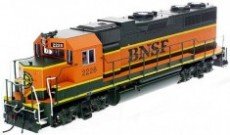Everything on model trains, model railroads, model railways, locomotives, model train layouts, scenery, wiring, DCC and more. Enjoy the world's best hobby... model railroading!
Converting Athearn Blue Box Locos to DCC with Sound
Travis asks readers:
“I’ve got 4 old Athearn Blue Box locos (DC) and I want to upgrade them to DCC with sound. A hobby shop said it’s doable but might not perform great. Has anyone done this successfully? What should I expect, and how can I get the best results?”
4 Responses to Converting Athearn Blue Box Locos to DCC with Sound
Leave a Reply
















While I’m not psychic, what the hobby shop was referring to is that many (most?) older locos have motors that draw a lot of power. This may result in DCC decoders being unable to supply enough power to the motor for the loco to perform well. You might want to measure the power draw on DC , or check the owner’s manual if you still have it, and verify if the decoder can handle it. It might be better if you actually replace the motor with newer ones that require less power.
The problem with the older locos is that they have very small 3 pole motors. The result being that their torque is very low. With any of the new digital systems, they have a hard time getting the loco to start moving. These systems have feedback so that the controller understands the motor characteristics to feed the appropriate voltage/current to the motor when under its control. They do not feed DC as we know it, but a pulsed waveform. In a pulse, there is always a point where the voltage goes to a zero invariably. DC does not have this issue. Once it is above zero, it is always above zero, so to speak.
I have tried a few of such motors with no luck with a different digital system and gave up because they simply don’t move at the lower settings and fails the programming altogether. I don’t know about DCC but I assume they all have the basics similar.
If you have 5 pole motors that are rare in older locos, it will work as they have much better torque. This is because, unlike a 3 pole armature, a five pole armature needs to turn much less for the next pole piece to become energized. 120deg. vs. 72 deg.
I have done several of my blue box locomotives and have not had a problem
Just make sure they are well maintained
Hi, I have done DCC o=conversions for myself and others who are my clients. I have a few rules.
1.I check the age of the loco, how long its been with the owner, was is bought second hand.
2. Are there any booklets or technical data that comes with the packaging and locomotive.
3.Check the type of pole in the motor. Modern motors are 5 and even 6 pole skewed with single and or double balanced brass flywheels.to give smoother running and torque.
4. Concentrating on older locomotives its important to check the stall current.. For this you will have to run your old locomotive on DC mode before any attempts at conversion of fixing a sound or mobile decoder.
5. To check the stall current (amps) you should place you locomotive on a piece of straight track and hold it down on to the track with your fingers and turn the throttle full power. Applying power to the track, attach a Multimeter to the milliamps setting. The full turn on of power and holding the locomotive will show a reading on the multimeter.It’s very important to check the reading of this stall current because if its exceeding 1.amp, the stall current is excessive and it’s not worth fixing a decoder because decoders can take a max of between 1 and 2 amps. If you are using a mini sound decoder, the amps it ca handle is less than one amp.
6. While it ay be fun to run your older locomotives, using sound decoders on locomotives that have borderline acceptable stall currents, the life of your decoder due to heat build up will kill it or cause malfunctions which will be very frustrating.
7. Remember old locomotives have had lost of wear and use carbon brushes which cause carbon dirt build on the commutator requiring regular servicing.
8. Try to dispose these older locomotives and buy a fewer newer model pre owned or brand new ones. Its Fully worth it. I’ve been down this path before. Try to buy DCC ready locomotives as many come in with built in speakers and it’s just a PNP (plug and play) that use 9 pin or 21 pin sund decoders.
9 I am a serious modeller, a specialist in servicing, and DCC conversions.
Converting or fitting Sound Decoders means understanding the watt output of the amplifier in the decoder and the matching single or dual speakers that have to be matched with the type of decoder. Tat is why sound decoders manufacturers recommend use of matching speakers and if they need to be wired in pararell or in series, depending n the decoder.
Thank You
Faizal Hathy
Sri Lanka